Menu
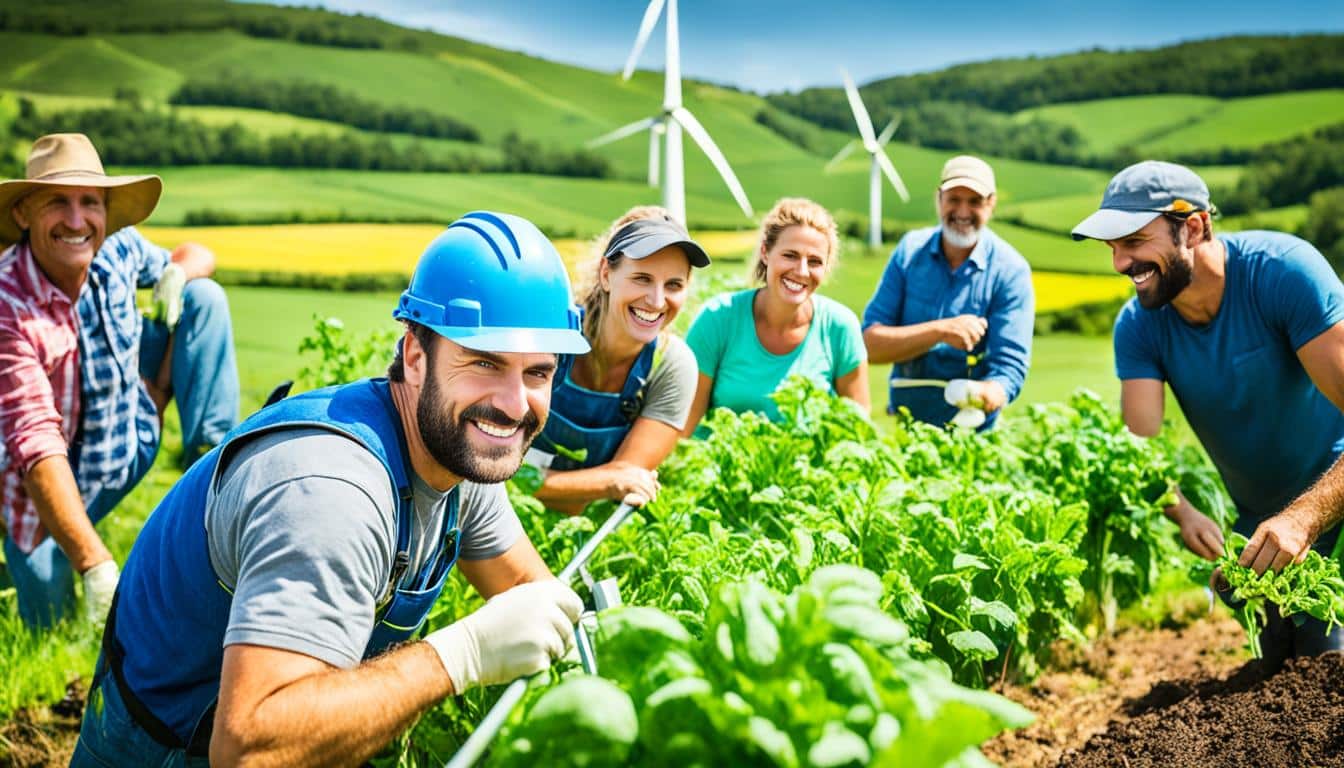
Did you know that normal farming has used a lot of fossil fuels, water, and caused problems like soil erosion? This is a big wake-up call to move to farming that won’t harm our planet further.
Farming in a way that’s good for the earth and feeds people is essential today. It should help farms stay strong even with climate changes. To do this, we need to mix old methods with new knowledge and technology.
Now, more and more farmers are working to make this happen. They’re using tools like GPS and GIS to farm more effectively. Classes on “Sustainable Agricultural Practices” are showing how to do this.
Sustainable agriculture is key for feeding people without harming the planet. It aims to grow food in ways that keep the environment safe. These methods help deal with the effects of our changing climate.
It’s important that farms produce a lot of food to feed everyone. But, they must do this without ruining the soil. Techniques like growing different crops in sequence and managing pests without harmful chemicals are vital.
This also helps farmers in places with little money grow more food. By making their fields more productive, it fights hunger and poverty around the world.
Sustainable farming also fights climate change. It does this by using fewer fossil fuels and saving water. Planting trees around fields, using smart farming technologies, and using clean energy are part of this.
It helps farms stay strong even as the climate changes. Working together on these methods is important worldwide.
Sustainable agriculture ensures farmers have a good living. The focus is on fair practices, boosting local economies, and keeping farming traditions alive. It’s a team effort involving leaders, sponsors, and big companies.
This way, farming is not just good for food and the earth. It also supports farmers and their communities, giving them a better life.
Strategies for sustainable farming are key to a strong, green agricultural future. The Advisory Committee on Sustainable Agriculture, made up of 22 groups, shows the power of working together. This includes organic farming unity and joint efforts in regenerative agriculture. The Agriculture and Agri-Food Canada finished its online meetings on March 31, boosting these teamwork efforts.
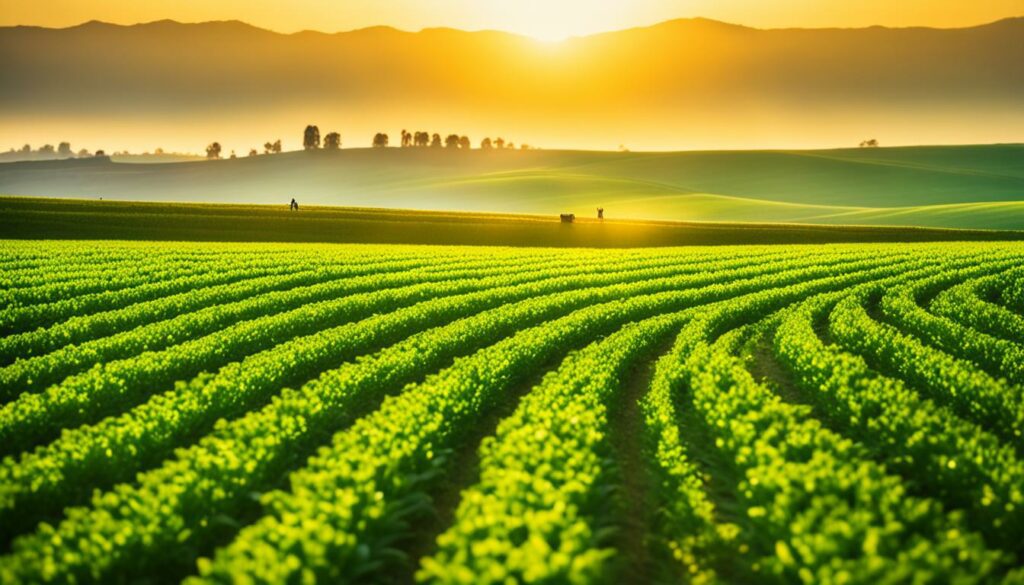
Canada aims to meet 2030 and 2050 climate goals with its Sustainable Agriculture Strategy (SAS). It focuses on key areas like adaptation, biodiversity, and climate change solutions. It also highlights the importance of soil health and water management.
The SAS takes a proactive approach to climate change to improve farm environments. It brings together farmers, researchers, and decision-makers. Their goal is a farming future that’s both successful and good for the planet.
Farmer-to-farmer networks are a great example of working together in organic farming. They share new tech, improve productivity, and cut down on harm to the environment. These networks also help farmers get the info they need and apply new ideas to their farms.
“The 23rd annual City Food & Drink Lecture, led by Sainsbury’s CEO Simon Roberts, echoes this call for closer, long-term partnerships across the food supply chain, underscoring the imperative of sustainability and maintaining British production.”
Teaching and training are crucial to making sure people in farming know how to be green. This effort is also seen in policy talks and spreading the word to support teamwork in making farms better.
Getting consumers involved is also really important. The more we educate and involve them, the more they can push for greener farming. This shows how important it is for farming groups to work together for a better future.
Bringing together old and new ways of farming benefits us and the earth. This mix meets today’s high standards while working around old farming’s limits.
Mixing old know-how with modern science helps the planet. This approach solves food and health problems. For example, in Bangladesh, combining rice with fish farming helps. A study by Ahmed and Garnett in 2011 proved this.
It’s vital to mix old and new farming tricks for the long run. Research, like Campbell et al.’s in 2014, backs this. They say it makes farming stronger and kinds to the planet. We need rules that back this mix. They keep our food and earth safe.
Using resources well is key for farming that’s good for the earth. Research, like Basche et al.’s in 2016, shows how cover crops help. This saves water and makes farms better. Using our resources smartly now makes us ready for tomorrow’s needs.
In Malawi, mixing different farming ways made families safer against hunger. This shows the power of working together in farming. When we share knowledge and tools, we all win. Together, we can farm in ways that help our world and keep on growing. Learn more about it here.
In the world of sustainable farming, new tools and methods are key. They help farms produce more while taking care of the planet. This includes using high-tech farming tools, saving rare plant types, and farming in a way that helps the land heal.
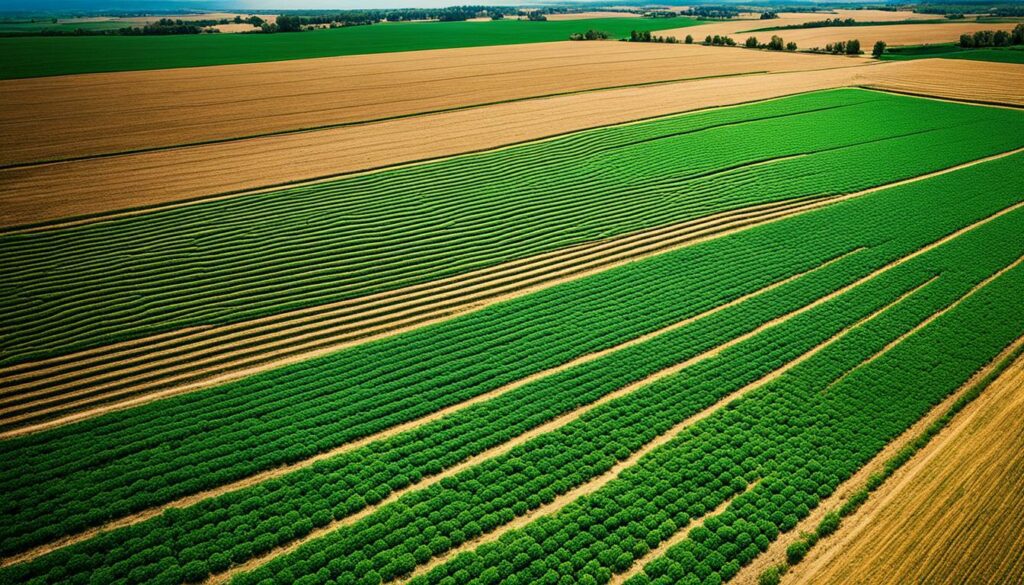
Precision agriculture is about using technology to farm smart. It uses tools like GPS to map fields and sensors to check on crops. This high-tech farming not only boosts harvests but also helps the environment.
Farms can now use data to farm in greener ways. This smart farming means we can grow food without hurting the planet.
Keeping our plant variety rich is crucial in farming for the future. Most of our food comes from just a few plants. But, there are thousands more we could use. Places like gene banks in Morocco protect these rare plants.
New tech also helps create plants that can fight off diseases, like special rice. These innovations mean good news for farmers and the food we eat.
Regenerative farming is all about making the soil, plants, and water healthier. It uses simple yet powerful ways to care for the land. This might be things like leaving the soil unturned or planting certain crops together.
The next generation of farmers is leading the charge in these new farming methods. They work with others in the community to produce food in a way that is good for everyone.
Eco-friendly farming partnerships help us work together for a better planet. Partnerships like the one above show the value of joining forces. Thanks to the Biden-Harris Administration’s support, ethical and green farming is getting a big boost towards a greener future.
The USDA’s early plan was to spend $1 billion on this. But, such a big idea attracted more interest. So, they decided to raise the budget to over $3 billion. This move shows how important funding is for supporting environmental care in agriculture.
Agriculture can be a big source of pollution. That’s why projects like these, which focus on clean and ethical farming, are so important. Many of these projects are led by groups of farmers working together. The dairy industry is also joining in, aiming for no pollution at all with the USDA’s help.
There’s great teamwork in the Potato Sustainability Alliance (PSA). It works with many different groups to make potato farming better for the planet and people. For example, they use smart strategies like rotating crops and using water wisely. Such actions show their dedication to using resources wisely.
The PSA also wants to grow its family and keeps everyone updated. They make sure all voices are heard. This way, everyone can pitch in to make farming more productive, profitable, and safe for the environment.
Now, let’s take a closer look at why these farming groups are so important:
| Investment Source | Amount | Focus |
|---|---|---|
| Biden-Harris Administration | $2.8 Billion | 70 Climate-Smart Projects |
| USDA | Increased to $3 Billion | Due to High Demand and Interest |
| Climate Smart Cotton Program | $90 Million | Environmental Stewardship |
These initiatives show us the power of working together for a common goal. By joining forces and sharing knowledge, we can make agriculture both strong and gentle on the Earth. This is vital for a sustainable and bright future.
Studying successful collaborations in agriculture shows us their powerful impact. For example, working together in local food projects can greatly improve a region’s food supply. It also benefits the environment and the incomes of those involved.
Studies in the European Union found that local food projects help economies and food safety a lot. They used a method to check the success of these efforts. It showed that what people within these projects do is more important than just the outside conditions.
This proves that if those involved really take charge, their projects are more likely to be sustainable.

In East Africa, growing fruit trees has had a big positive impact. It helps with food, the environment, and jobs. These projects are successful because the local people have a big say in how things are done. It shows us that when communities take the lead, real change can happen.
In Guatemala, growing coffee sustainably has worked really well because everyone came together. They used new, earth-friendly ways to farm. One farm even found they saved money and grew more food this way.
Such projects in Guatemala prove that focusing efforts in the right way can do a lot of good and set a good example for others.
| Case Study | Key Success Factors |
|---|---|
| Regional Foodsheds | Internal actor-related factors, long-term evolution |
| East African Fruit Tree Projects | Organic practices, biodiversity, grassroots agency |
| Guatemalan Coffee Farming | Innovative farming methods, local market support |
Looking at these cases, we see the role of planning and managing in success. So, when people in a project regularly review and better their ways, they meet the changing needs better. This leads to a stronger and more sustainable agriculture over time.
Sustainable farming brings together big challenges and great chances. To switch to sustainable ways, understanding new farming methods, keeping soil healthy, and saving nature are key. The main tests include fighting weeds off with herbicides, dealing with climate change, and keeping the earth’s soil healthy. Tackling these issues lets us grab the chances of sustainable farming.
Crops facing weed killers that don’t work anymore are in danger. Farmers need to use many ways to pull out weeds. This includes not only using different tools but also finding ways to work with nature to fight off weeds. Using methods that care for the soil can cut down the need for harsh chemicals. This helps make our farm lands strong and resistant to problems.
Stable climate helps plants grow well, but this is changing because of climate change. Farming must adapt to this by creating plants that can handle the change and by using water wisely. Figuring out the best ways to water plants and keep bugs away can fight this problem. It helps farming continue to be a dependable source of food.
Good soil and lots of different life forms are key to farming for a long time. Harmful ways of farming, such as too much use of fake fertilizers and ploughing too deep, hurt the earth. By farming in a way that helps the earth recover, we can make the soil and life in it richer. Growing different types of crops together or adding trees to the fields improves farmlands and brings more chances to farm well.
| Challenges | Opportunities |
|---|---|
| Herbicide resistance | Integrated weed management |
| Climate change impacts | Climate-resilient crops |
| Soil degradation | Regenerative agriculture |
| Water scarcity | Efficient irrigation |
| Biodiversity loss | Agroforestry |
In the end, making farming more sustainable is hard but worth it. By coming up with smart and shared answers to these issues, we can make a farming future that’s tough and kind to our planet.
Global Positioning Systems (GPS) have changed modern farming for the better. They offer new ways to boost efficiency and yield. With GPS in farming, we can cut down on resources and lessen negative environmental impact. This technology is crucial in managing farm resources well and in keeping farming sustainable.
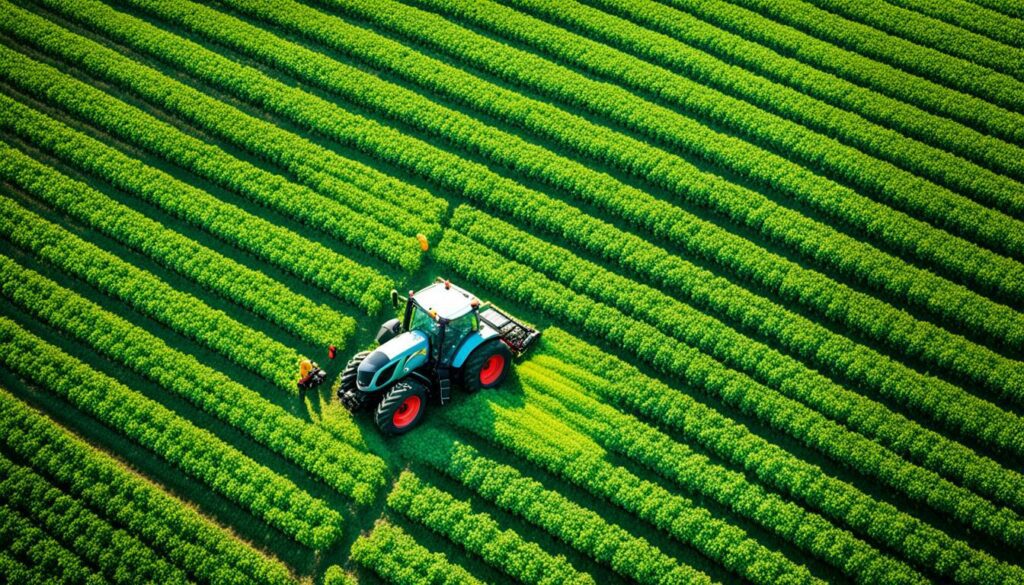
Across the UK, farmers love using GPS for its precision, savings, and simplicity. It means less spending, better crops, and a friendlier environment. They use GPS to create maps of fields, roads, and water systems. It also helps spot plant and crop problems early, ensuring the right areas get treated.
Precision farming with GPS is a win for both farmers and nature. GPS guides crop planes to spray fields accurately. This cuts chemical drift and the need for as many chemicals. It saves money and is better for the Earth. More devices, like GPS, in farming means sectors growing, showing its importance further.
Precision farming helps in using inputs better, making the most out of them while using less where needed. GPS tracks and compares crop yields across fields, helping farmers focus efforts smartly. With the US launching new GPS signals, farming will only get more effective. Such great communication, like 5G between farm machines, makes work smooth and avoids doing things twice.
Working together for better soil health is key today. Methods like the 4R Nutrient Stewardship help use nutrients more wisely. This method looks at the right source, rate, time, and place for nutrients. It has greatly improved soil health.
Farmers are now using these ideas and changing how they farm. They’re finding new ways and tools for farming that heal the soil. The Soil Renaissance started in 2013 is a big success. It has shared a lot of research on how to make soil healthier.
But, there’s still a big problem with weeds that don’t die with regular weed killers. Farmers are spending more money and effort to control them. This problem shows why we need to come together for the soil.
Regenerative farming is a great answer. It uses natural ways like cover crops to fight weeds and improve the soil. This way, farming is less about chemicals and more about working with nature.
Sharing know-how among farmers helps a lot too. Farmer-to-farmer networks are great for this. They talk about tips and ideas to fight weed problems. Many experts from these networks have discussed weed challenges and how to tackle them.
Group efforts go beyond just farmers. Projects with different organisations and companies also push to help the soil. For example, AgriCircle and SGS are working with FiBL and INRAe on a new soil carbon standard. This will help farmers make smarter choices for the soil’s health and our food’s future.
By working together, we can fight big issues in farming like weed resistance and soil damage. If all in the farming world pitch in, we can make our soil thrive. This way, we set up a path for a farming future that’s good for all.
Getting money and know-how for farms is key for eco-friendly farming. Everyone from the government to private folks helps out. Right now, less than a quarter of global money in this area goes to farming. And, only 10% of all the money given out is for farms. But, this scene is changing with more cash and new ways of help.
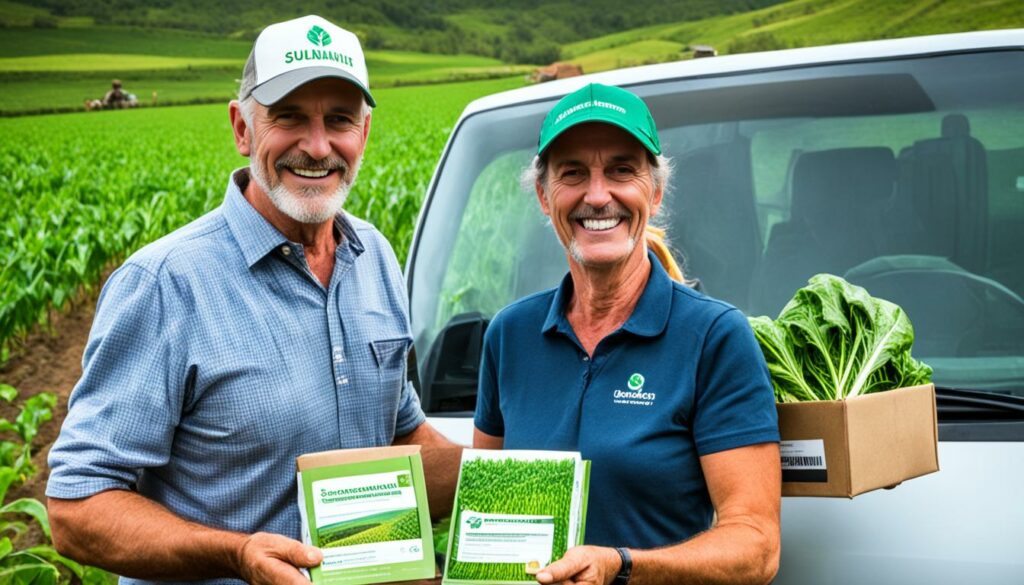
Governments and big groups are essential for making sure we farm the right way. The Better Cotton Fund and the Resilient Agriculture Accelerator Fund are good examples. They gather money from governments, big names, and others to improve cotton growing and regenerative farming. These show how much support from big groups and governments means for eco-farming.
Businesses investing in smart farming help a lot in spreading new ideas and keeping resources around. These days, companies can sell bonds or take loans for eco-projects. This way, they get cheaper money and it makes sense to invest in being green. The value of green financial deals hit $1.3 trillion, with more than $500 billion used at the end of 2020. This shows how much more companies are doing for the planet.
Local innovations and farmer groups are key in eco-farming. They help share what works and they find new ways to grow crops. For example, banks are starting to offer special loans for farmers helping the environment. This way starts from the people and makes sure eco-farming ideas fit the area and the people who live there.
Sustainable farming is a beacon of hope. It helps with big environmental and social issues. Such as climate change, less water, and changing weather. These methods aim for harmony with nature. They also ensure we keep having enough to eat.
Sustainable farming makes a big difference in fighting hunger and poor nutrition. By using methods like crop rotation and organic farming, we make the soil healthier. This leads to more food. More food means less hunger and better nutrition. And with a focus on growing different crops, it helps fight malnutrition.
Farmers who work sustainably help their communities in many ways. They create jobs and support fair trade. This especially helps smaller, family-owned farms do well. It keeps life stable in rural areas. Working together in local food chains also brings new, organic ways of farming.
Sustainable farming helps rebuild nature’s important jobs. Things like soil eroding and pollution are big problems from older farming ways. But, sustainable farming works to fix these. By taking care of the soil, using less chemicals, and smart irrigation. It also plants trees and uses special crops. This helps the land, cleans the water, and stores more carbon from the air.
| Conventional Agriculture Challenges | Sustainable Farming Solutions |
|---|---|
| Soil erosion | Cover cropping, no-till farming |
| Biodiversity loss | Crop rotation, intercropping, agroforestry |
| Water pollution | Efficient irrigation systems, conservation tillage |
By using these methods, sustainable farming makes our world better. It mixes new and old ways of farming. This makes a strong system that’s good for everyone and the Earth.
In sustainable agriculture, creating new types of crops is vital. These changes help meet the increasing need for food. By 2050, food demand could go up by 70% because of more people. Thanks to new sciences, we’ve been able to tweak genes in crops. This improves things like their ability to survive drought, resist pests, and use nutrients better.

Genebanks are key in keeping many different crop types for the future. This helps make crops ready for a changing climate. Agriculture is also turning more to methods that are gentle on the planet. Things like rotating crops, not using chemicals, and being smart about fighting pests can make crops healthier. This saves water and cares for the soil and wild plants.
Putting farms in tall buildings in cities has been a big step forward. These farms use much less water. They also cut down on how far food travels to reach people. By using air and water to feed plants, these high-tech farms are shaking up how we grow food. They even use flying drones and satellites to watch over the crops. This makes farms better at producing food while doing less harm to nature.
New ways to help crops grow better are having a big impact. For example, bees carrying good things to flowers have boosted the value of crops in the U.S. by a lot. And another technology makes sure farmers plant their crops exactly right. This makes the soil healthier and the farm more productive.
| Innovation | Benefits |
|---|---|
| Gene Editing | Enhanced drought tolerance, pest resistance, nutrient use efficiency |
| Vertical Farming | 70% less water usage, reduced transportation costs and emissions |
| Bee Vectoring Technologies | Contributes $20 billion to U.S. crop production |
| RTK Technology | Centimetre-level accuracy in field mapping, improved soil health |
These new ideas show us the best way to make farming better. It’s by joining old farming with new technology. This balance is the key to making sure we can feed everyone now and in the future.
The world of sustainable farming shines with new tech and ways of working. It’s vital to check future farming trends and offer advice. This is key for a strong, global farming community.
New tech is changing how we farm, making it better for the planet. Farming uses lots of water and land. So, tools like drip irrigations help us use water wisely. This tackles a big farm issue.
Also, a farming method called precision agriculture is growing fast. It should be worth over USD 9.34 billion by 2022. This system uses soil maps and special crop plans to boost food making without using too many resources. It’s great for the environment.
Getting young people into farming brings new ideas and skills. They’re great at using new tech like AI for pests, drones for checking crops, and eco-friendly machines. This helps farming be eco-friendlier. It secures farming’s future and moves it towards being sustainable.
Farming wisely can cut down on waste and pollution. By 2050, we could make a big dent in emissions. This could happen by using new farming methods and changing how we eat.
Shifting to different proteins could save lots of land. These smart steps are vital for eco-friendly farming’s future. They guide how we farm, making sure we keep the planet healthy while feeding everyone.
The future of farming sustains on all fronts. This means using new tech, involving the youth, and following strong policies and studies. All of this is crucial for a strong, global farming scene.
Nurturing new partnerships in sustainable farming is key. The report looked at 30 examples of groups working together in the EU. It found they made big improvements in the land, helping it become more sustainable.
The study showed that what goes on inside the groups is really important. It’s more important than what’s happening outside them. These teams can negotiate better, invest more, and have more chances to get funds. They work smarter, spend less, and solve problems together.
When aiming for both social and money-making goals, things get complex. But, how these groups’ teamwork grows with time is most vital. It shows that with a full-on, varied strategy, we can make farming strong and keep the environment healthy. This approach will lead us to a future where we can both feed ourselves and protect the planet.
The goal of sustainable farming collaboration is to bring together farmers, researchers, and policymakers. They work to make agriculture greener, profitable, and open to all. They form partnerships to bring new, eco-friendly ideas to farming.
Nourishing people and protecting the environment is key. It makes sure farming benefits people’s health without harming the earth. This balance is vital for food security and nature’s health.
Sustainable agriculture fights and adapts to climate change. It does this through varied crops, less soil disturbance, and planting cover crops. These methods cut emissions and help farms withstand bad weather.
Organic farming and regenerative agriculture are crucial in sustainable farming. They work to: improve soil, boost biodiversity, and cut down on artificial products. This way of farming sees the big picture, caring for the earth, economy, and people.
By combining old and new farming ways, we get the best of both. Traditional methods keep local life and knowledge alive. New tech like GPS boosts efficiency and crop yield. This mix makes farming strong and efficient.
Sustainable farming uses gadgets like GPS and maps to farm precisely. It looks after local plant and animal life. It also focuses on making soil and land healthy again.
Inspiring projects include making local food systems strong and growing more fruit trees in Africa. They also cover helping small coffee farmers in Guatemala switch to organic and fair trade. Such alliances show we can reach goals together.
Challenges include weed killers that stop working, a changing climate, and keeping soil healthy. Covering the land to protect it, supporting varied life, and using smart methods reduce the need for chemicals. Teamwork is key to solving these issues well.
GPS helps farming become greener by guiding exact practices. This tech aids in planting, watering, and feeding crops in the best ways. The result is smarter and more eco-friendly farming.
Working together improves soil health by sharing smart ideas. For example, the 4R Stewardship highlights the right ways to feed the soil. This teamwork is vital in the effort for better, lasting land care.
Sustainable farming gets support from government, businesses, and local groups. This help lets farmers embrace eco-friendly practices and get new tech. It’s a way to build stronger, greener farms.
Sustainable farming not only fights hunger and boosts rural lives but also helps nature thrive. It leads to better soil, cleaner water, and more life. A healthy earth means a better life for us all.
New plant types are key in farming for the future. They protect themselves better from pests and diseases. They also cope with a changing climate, offering hope for a secure food future.
Trends like new tech, more young farmers, and support for green goals show a promising future. These signs point to a farming that’s stronger, kinder to the planet, and more productive.